Life cycle assessment and product green design

Product Life Cycle
To reduce the environmental impact of its products, Primax evaluates the environmental impacts at each stage of the product life cycle in accordance with international standards ISO 14040 and ISO 14044 and incorporates green design principles. Since 2013, Primax has conducted product carbon footprint studies using the life cycle assessment methodology based on ISO 14067, selecting representative products for evaluation. Given the Group's extensive product portfolio, Primax has adopted a phased strategy to complete carbon footprint calculations across product categories.
In 2023, the Group developed a Sustainability Control Tower management system to support carbon footprint assessments and serve as the foundation for low-carbon product design. In 2024, life cycle assessments of the carbon footprint were completed for 17 major products, including mice and keyboards (wired, wireless, and gaming), network cameras, wireless charging pads, game controllers, docking stations, surveillance cameras, access control systems, multifunction printers, thermal printers, Bluetooth speakers, and headphones. The assessment covered raw material production, transportation, manufacturing, product transport, product use, and end-of-life treatment, representing approximately 51% of revenue. Going forward, Primax will further expand carbon footprint inventories and low-carbon product design efforts. Additionally, in 2025, the Group plans to develop a real-time carbon footprint reporting system for all mass-produced products to provide timely support for eco-design and low-carbon design analysis activities.
Continue to reduce the environmental impact posed by products
As a company primarily engaged in contract manufacturing and assembly, Primax is committed to ensuring that every stage of the product life cycle, from upstream product design to end-of-life treatment, moves toward greener and more circular practices while meeting customer requirements. In 2024, we continued to increase the proportion of recycled plastics used in raw materials. In the production and manufacturing stage, product design improvements and advances in production techniques helped reduce labor hours. At the end-of-life phase, we adhered to WEEE compliance principles and monitored the disassembly rates of Primax products.

Green Product Design
Between 2023 and 2024, the Group gradually established foundational capabilities in eco-design and low-carbon design and developed a product carbon footprint information system to compile baseline data for product carbon footprints. In 2024, Primax officially launched low-carbon design projects for major products and set a design target to reduce the carbon footprint of these products by more than 20%. This target has also been incorporated into the performance management and incentive mechanisms for R&D leadership.
Low-Carbon Design Projects
In 2024, resources invested in green product design totaled NT$69.46 million, including investments in personnel resources, project expenses, dedicated equipment, carbon footprint management system development, and training.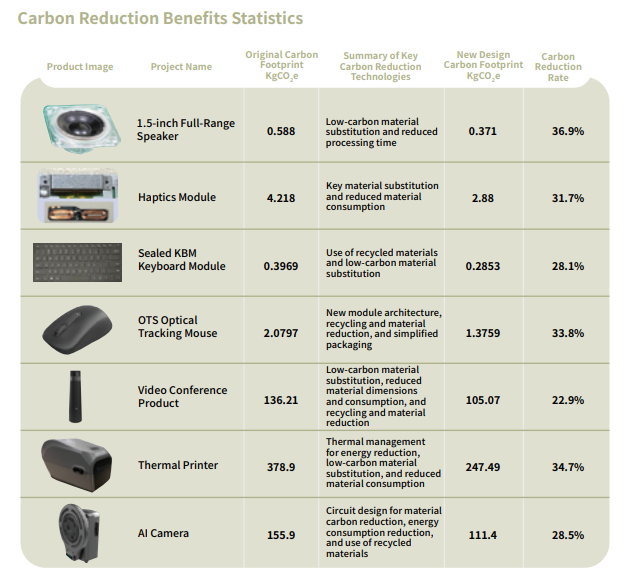
Chemical and hazardous substance management
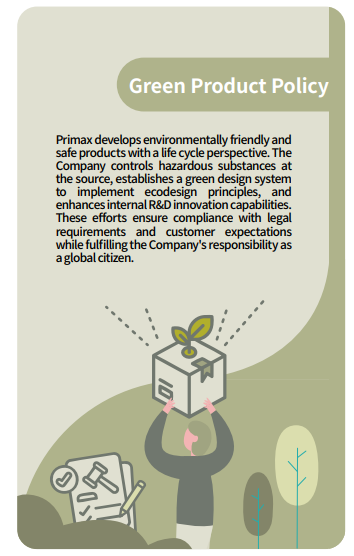
Primax Group strictly complies with the chemical safety regulations applicable in various countries and customers' requirements on prohibited and restricted substances. By controlling the stages including design, procurement,manufacturing and output comprehensively, it expects to move toward the goal of zero health and safety hazards and zero environmental pollution. Primax never incurred any chemical spills or other incidents in 2024 .
Focus on the chemical laws and regulations development trend
Primax Group operates production sites across multiple regions. Accordingly, we closely monitor chemical-related regulations in each location, including but not limited to the European Union Restriction of Hazardous Substances in Electrical and Electronic Equipment Directive (RoHS), Registration, Evaluation, Authorization and Restriction of Chemicals (REACH), Persistent Organic Pollutants Regulation (POP), the Environmental Protection Agency Toxic Substances Control Act (TSCA), California Proposition 65, Limits for Volatile Organic Compounds Content in Cleaning Agents, Limits for Volatile Organic Compounds Content in Adhesives, and other international standards and Chinese national regulations.
In line with applicable regional regulations and customer requirements, Primax Group has established the Primax Green Product Chemical Substance Restriction Specification. Through coordinated oversight by multiple departments, including Environmental Health and Safety, Production, Green Product, and Product R&D, the Group manages the use of chemicals at every stage of the manufacturing process.
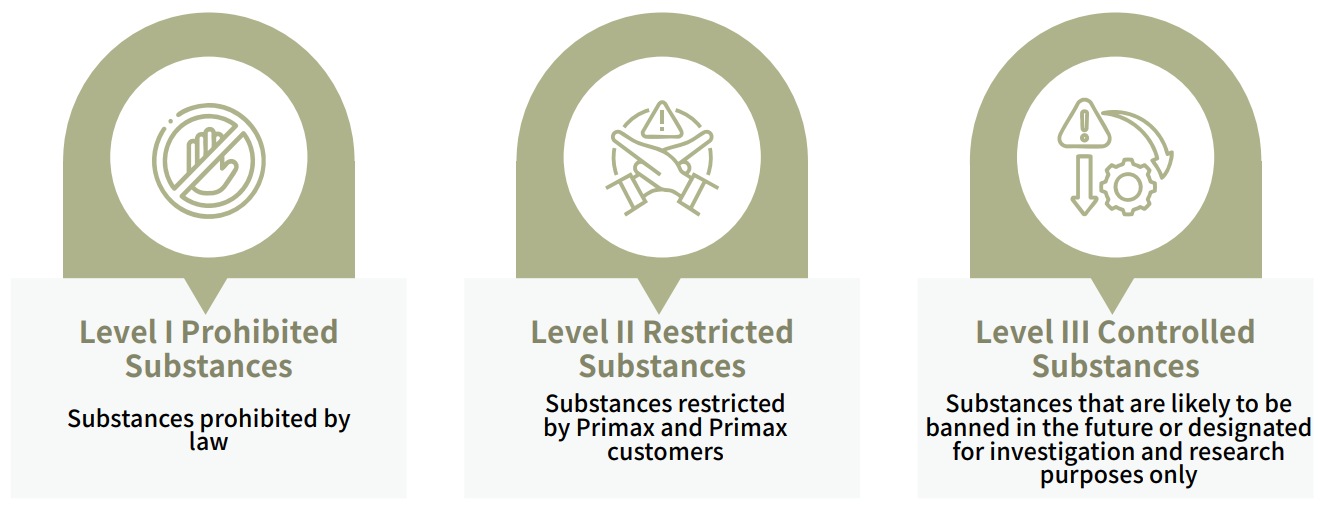
Primax Group's Green Product Management Platform
To implement effective source control, Primax utilizes a Product Data Management (PDM) system as its core platform, integrated GP Portal®, SAP®, and other information systems to build a comprehensive management infrastructure. This approach effectively reduces operational costs and improves processing efficiency. It also consolidates customer regulatory requirements, design processes, supplier management, procurement, production, and training into unified workflows, ensuring strict compliance and effective execution at every stage. Suppliers must guarantee that all products sold to the Group, including their raw materials, dyes, solvents, consumables, packaging, and processes, do not contain or use any hazardous substances prohibited by the laws of the countries where the products are marketed. All products must also comply with the requirements set forth in the Primax Group Green Product Chemical Substance Restriction Specification.
Full Material Declaration (FMD)
Primax Group integrates its PDM®, GP Portal®, and SAP® management systems to identify the material composition of all components. Suppliers are required to upload and regularly update the complete raw material content of their components into the GP Portal, enabling Primax to assess the potential impacts of these parts on health and the environment. The Group has also incorporated all controlled substances listed in IEC 62474 into the GP Portal database. This allows clear tracking of whether materials provided by suppliers contain any substances regulated under IEC 62474, thereby ensuring compliance and enabling traceability of upstream chemical usage.
In response to customer requirements, Primax discloses information on hazardous substances, including 100% product health and safety assessments, declarations of conformity, hazardous substance test reports, material safety data sheets, and safety/EMC compliance reports. In 2024, there were no incidents of non-compliance with health and safety regulations or voluntary codes related to products and services, and no record of fines or sanctions.
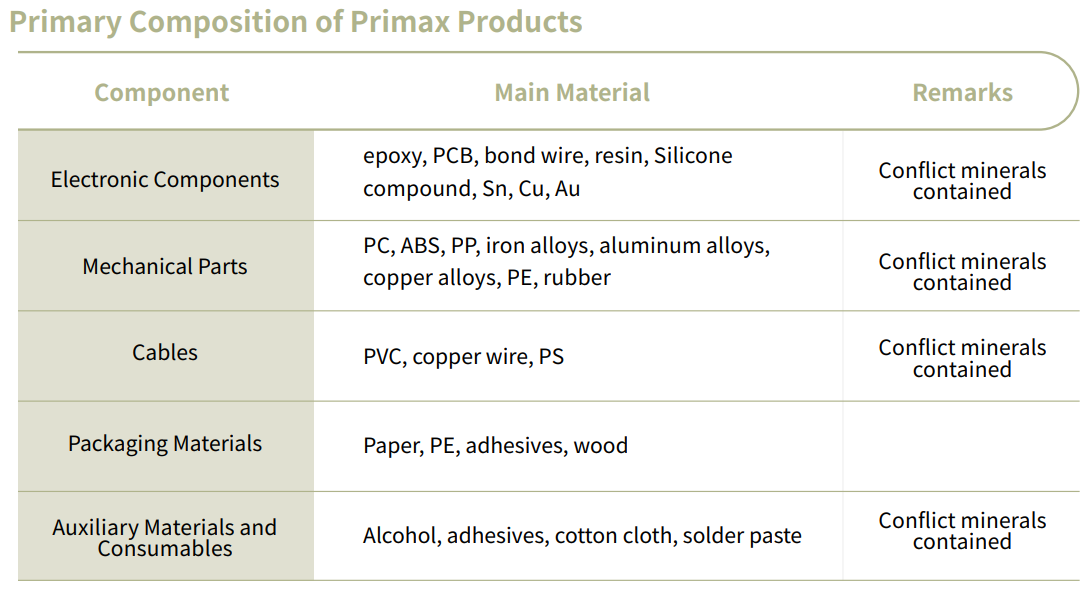
IECQ QC 080000 Hazardous Substance Process Management System Certification
Primax Group's hazardous substance management efforts are guided by International Electrotechnical Commission's IECQ HSPM QC 080000 standards(Electrical and Electronic Components and Products Hazardous Substance Process Management System Requirements), and we have obtain a third-party verification certificate, as per which we duly manage hazardous substancesin products. These standards are being followed strictly from customer/legal requirements, component identification, supplier management, raw materialexamination, production, inventory, shipment, to employee training.
Results and plans for elimination of hazardous substances
In 2023, Primax identified nine chemicals prioritized under the Industry Focus Process Chemicals Policy (IFPC Policy) of the RBA for inventory and assessment. By the end of 2023, the use of these substances had been fully prohibited, and all raw materials and auxiliary consumables now comply with the requirements.
In 2024, the Group initiates an investigation into per- and polyfluoroalkyl substances (PFAS) and will progressively reduce the use of non-polymeric PFAS, aiming for completion by 2026. Additionally, to reduce VOC emissions, Primax will develop a VOC source reduction plan and proactively increase the use of low-volatility adhesives.
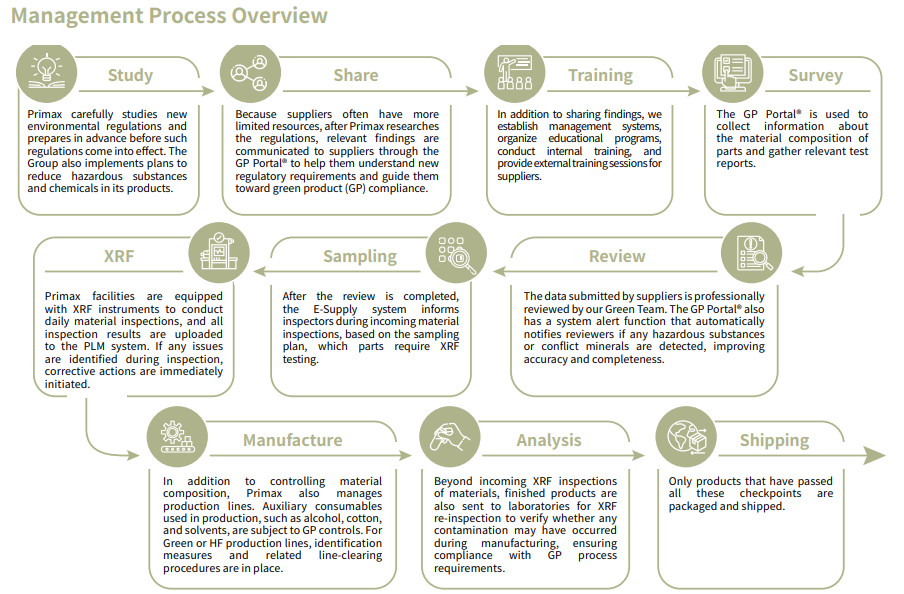
Environmental Labels & Declarations
The products produced by Primax are mainly OEM and ODM products, and we will assist clients to apply for type 1 eco labels, such as Energy Star, EPEAT,(for multifunctional office machines and scanners), Taiwan's Green Mark (formouses), China's Ten-Ring verification (for scanners), and electrical safety verification (such as EU CE or China CCC). The power supplies of audio productshave all received the Energy Star mark. We combine the product green design capabilities and realize the concept of green environmental protection and sustainable operation, expecting to meet customers' needs and also increase the competitiveness of the Company's products.
Green Procurement
Since 2022, Primax Group has been promoting Green Procurement Principles to improve the organization's operational energy efficiency and to advance environmental benefits and economically favorable sustainable development for society as a whole. For high-volume purchases of IT products (such as computers, monitors, multifunction devices, printers) and high-energy-consuming equipment (such as refrigerators, water dispensers, and chillers), priority is given to products certified with domestic or international eco-labels or energy efficiency labels (including EPEAT, Eco Label, Energy Star, TCO, Blue Angel ,and others). In 2024, the procurement value of eco-labeled products reached NT$32,711 thousand, accounting for 58.84% of total procurement.
Raw material consumption statistics
In 2024, Primax Group's total raw material consumption amounted to 78,807 metric tons, representing an 8.62% decrease compared to 2023.

Table of raw material consumption (Unit:kg)
| Name of material | 2021年 | 2022年 | 2023年 | 2024年 | |
| Metal | Iron | 6,859,658 | 5,878,439 | 4,374,819 | 3,679,718 |
| Aluminum | 1,474,652 | 1,148,222 | 443,908 | 613,783 | |
| Copper | 108,236 | 52,687 | 468,17 | 812,404 | |
| Other Metals | 8,945,821 | 3,318,201 | 2,110,6708 | 73,700,605 | |
| Non-metal Materials | 29,540,908 | 31,528,743 | 32,816,380 | 36,727,843 | |
| Electronic Materials | 31,078,493 | 21,390,279 | 14,221,588 | 11,097,478 | |
| Packaging Materials | 27,907,680 | 22,995,035 | 31,808,220 | 21,525,572 | |
| Total | 105,915,448 | 86,311,606 | 86,243,763 | 78,806,510 | |

